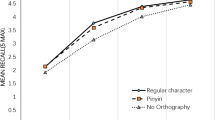Abstract
The influence of different vocabulary instructional techniques upon the acquisition of different language words was examined in two experiments. In Experiment 1, comparisons were made between the learning of Chinese and French words employing both paired-associate presentations and spacing procedures. The results supported the view that language transfer affects the acquisition of second language words, with more French words being learned than Chinese words. The superiority of the spacing procedure over the paired-associate presentation found in these results suggested that the spacing method diminished the adverse effects of blocking and thus enhanced learning. However, no significant interaction between the teaching procedures and different language words was detected. That is, under the spacing procedure, greater improvement in learning of Chinese words was not found. The experiment was thus modified by substituting the spacing procedure with aural feedback in Experiment 2. In this experiment, a significant interaction between these two factors was detected. That is, the recall for French was more than Chinese in the paired-associate condition, however, under the aural feedback, performance in Chinese was statistically equivalent to that in French. Hence, these findings may contradict the prediction of language transfer. It appears that the phenomenon of language transfer may be far less important in vocabulary learning than the use of a method of instruction which neutralises the negative effects of blocking.
Similar content being viewed by others
References
Ard, J., & Homburg, T. (1992). Verification of language transfer. In S. Gass and L. Selinker (Eds.),Language transfer in language learning (pp. 47–70). Rowley, MA: Newbury House.
Deno, S. L. (1968). Effects of words and pictures as stimuli in learning language equivalents.Journal of Educational Psychology, 59, 202–206.
Ellis, R. (1994).The study of second language acquisition. Oxford: Oxford University Press.
Flynn, S. (1987). Contrast and construction in a parameter-setting and model of L2 acquisition.Language Learning, 37, 19–62.
Gass, S. (1984). A review of interlanguage syntax: Language transfer universals.Language Transfer, 34, 115–132.
Gass, S. (1983). Language transfer and universal grammatical relations.Language Transfer, 29, 327–244.
Gass, S., & Selinker, L. (1994).Second language acquisition: An introductory course. Hillsdale, NJ: Lawrence Erlbaum.
Judd, E. L. (1978). Vocabulary teaching and TESOL: A need for re-evaluation of existing assumptions.TESOL Quarterly, 12, 71–76.
Kamin, L. J. (1968). “Attention-like” processes in classical conditioning. In M. R. Johns (Eds.),Miami Symposium on the Prediction of Behavior 1967: Aversive Stimulation (pp. 9–31). Coral Gables, FL: University of Miami Press.
Kamin, L. J. (1969). Predictability, surprise, attention and conditioning. In B. A. Campbell & R. M. Church (Eds.),Punishment and aversive behavior (pp. 279–296). New York: Appleton-Century-Crofts.
Kehoe, E. J. (1982). Conditioning with serial compound stimuli: Theoretical and empirical issues.Experimental Animal Behavior, 1, 30–65.
Kehoe, E. J. (1987). Selective association in compound stimulus conditioning with the rabbit. In E. Gormezano., W. F. Prokasy. & R. F. Thompson (Eds.),Classical conditioning (3rd. ed), (pp. 161–196). Hillsdale, New Jersey: Lawrence Erlbaum Associates.
Kellerman, E. (1983). Now you see it, now you don't. In S. Gass & L. Selinker (Eds.),Language transfer in language learning (pp. 112–134). Rowley, MA: Newbury House.
Lang, R. J., & Solman, R. T. (1979). Effect of pictures on learning to read common nouns.British Journal of Educational Psychology, 49, 138–149.
Larsen-Freeman, D., & Long. M. (1991).An introduction to second language research. London: Longman.
Laufer, B. (1990). Why are some words more difficult than others? Some intralexical factors that affect the learning of words.International Review of Applied Linguistics, 28, 293–307.
Odlin, T. (1989).Language transfer Cross-linguistic influence in language learning. Cambridge: Cambridge University Press.
Palmberg, R. (1985). How much English vocabulary do Swedish-speaking primary-school pupils know before starting to learn English at School?Publications of the Research Institute of the Abo Akademi Foundation, 105, 89–97.
Pickering, M. (1982). Context-free and context-dependent vocabulary learning: an experiment.System, 10, 79–83.
Rescorla, R. A., & Wagner, A. R. (1972). A theory of Pavlovian conditioning: variation in the effectiveness of reinforcement and nonreinforcement. In A. H. Black & W. F. Prokasy (Eds.),Classical conditioning II (pp. 64–99). New York: Appleton-Century-Crofts.
Ringbom, H. (1978). The influence of the mother tongue on the translation of lexical items.Interlanguage Studies Bulletin-Utrencht, 3/1, 80–101.
Ringbom, H. (1987).The role of the first language in foreign language learning. Clevedon, Avon, England: Multilingual Matters.
Ringborm, H. (1992). On L1 transfer in L2 comprehension and L2 production.Language Learning, 42, 85–112.
Rivers, W. A. (1964).The psychologist and the foreign language teacher. Chicago: University of Chicago Press.
Royer, J. M. (1973). Memory effects for test-like-events during acquisition of foreign language vocabulary.Psychological Reports, 32, 195–198.
Saunders, R. J., & Solman, R. T. (1984). The effect of pictures on the acquisition of a small vocabulary of similar sightwords.British Journal of Educational Psychology, 54, 265–275.
Singh, N. N., & Solman, R. T. (1990). A stimulus control analysis of the picture-word problem The blocking effect.Journal of Applied Behaviour Analysis, 23, 525–532.
Selinker, L. (1983). Language transfer. In Gass, S. and Selinker, L. (Eds.),Language transfer in language learning. (pp. 33–53) Rowley, MA: Newbury House.
Solman, R. T., & Adepoju, A. A. (in press-a). First language words as extra-stimulus prompts in learning second language vocabulary.International Review of Applied Lingusitics.
Solman, R. T., & Adepoju, A. A. (1995). The effect of aural feedback in second language vocabulary learning.Journal of Behavioural Education, 5, 433–446.
Solman, R. T., Singh, N. N. & Kehoe, E. J. (1992). Pictures block the learning of sightwords.Educational Psychology, 12, 143–153.
Solman, R. T., & Wu, H-M. (1995). Pictures as feedback in single word learning.Educational Psychology, 15, 227–244.
Webb, W. B. (1962). The effects of prolonged learning on learning.Journal of Verbal Learning and Verbal Behavior, 1, 173–182.
Webber, N. E. (1978). Pictures and words as stimuli in learning foreign language response.The Journal of Psychology, 98, 57–63.
Wu, H-M., and Solman, R. T. (1993). Effective use of pictures as extra stimulus prompts.British Journal of Educational Psychology, 63, 144–160.
Author information
Authors and Affiliations
Rights and permissions
About this article
Cite this article
Solman, R.T., Chung, K.K.H. Language transfer and blocking in second language vocabulary learning. J Behav Educ 6, 173–190 (1996). https://doi.org/10.1007/BF02110231
Issue Date:
DOI: https://doi.org/10.1007/BF02110231




